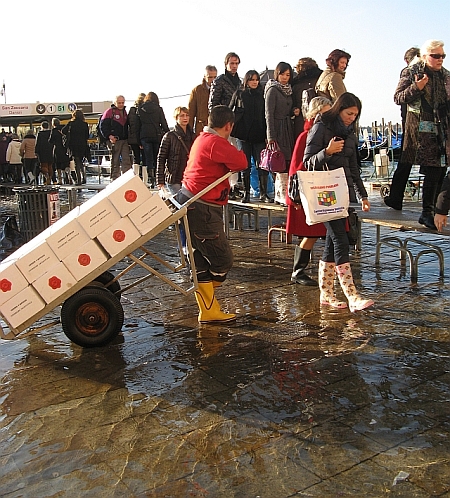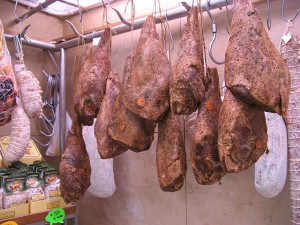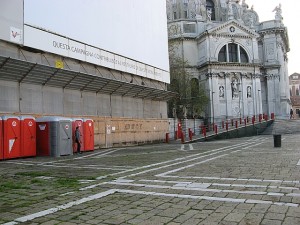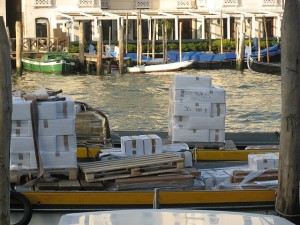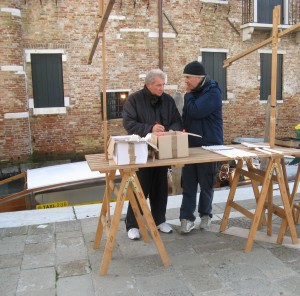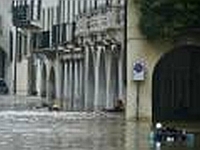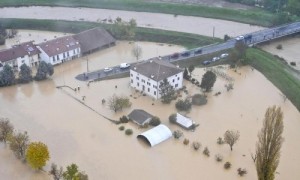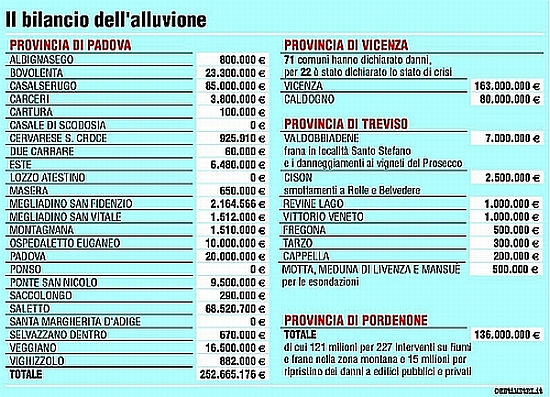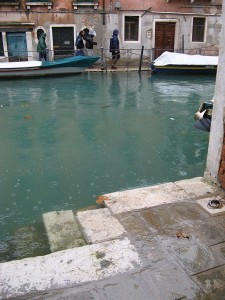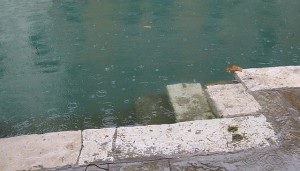I have often mentioned that predictions of high water in Venice turn out to be as accurate as weather predictions anywhere else. Sometimes even less accurate, given how sensitive the whole lagoon situation is to all sorts of factors, including wind.
The last week or so has undoubtedly been rather trying for the dauntless Paolo Canestrelli, director of the Tide Center. Because while the Gazzettino, rightly or wrongly, published a series of articles that sounded fairly alarmist: “Feast of the Salute with your hipboots,” “Feast of the Salute with no walkways,” “F of the S at 120 cm [four feet] of high water,” and so on, it didn’t turn out quite that way.
These stories were irksome for a few reasons, none of which had to do with whether or not I had to put on my hipboots.
First, the area around the basilica of the Salute is much higher than the Piazza San Marco, therefore a tide prediction which sounds drastic in one place won’t be nearly so much so in another.

Second, so far this autumn few forecasts have turned out as given. The 120 cm repeatedly predicted for Sunday morning? We got 103 [3 feet].
The tide did finally manage to pull itself up to 122 cm, but that was at 12:10 Sunday night, when probably there weren’t many people or taxis or barges around to be inconvenienced.
A few nights later, the sirens sounded with two additional tones, signaling the probable arrival of 120-130 cm [4-5 feet] of water. Two tones means that we will have some water about halfway up the street outside our door. But in the end, our canal did no more than kiss the edge of the fondamenta. The fact that there was virtually no wind also helped.
Regardless of the height or non-height of the eventual water, articles dramatize that the city has “water on the ground” without specifying the depth — sometimes it can be two inches, but the term “high water” is usually used by the media to sound as if the levees have broken. And these articles never mention how much of Venice has water, making it sound as if the entire city were going under. Someone might be sufficiently original as to publish a story that says “Two tones means that up to 29 per cent of the city is under water,” but I have yet to see one that says “71 per cent of the city is bone dry.”
I realize that drama is entertaining, but why dramatize it at all? It’s not dramatic. It’s temporarily slightly tiresome, at a very low level on the Zwingle Slightly Tiresome Index. I’d rate it a 2, the same as hanging out the laundry.
This would qualify as a true annoyance. For some reason this delivery-person was put ashore at an ill-advised spot near San Marco, and now his way forward is completely blocked by the walkways. (They spread out in a long T-shape beyond the edge of this picture.) He has obviously recognized that his only option is to wait till the workmen make a break in the barrier, which will be soon, considering how far down the tide has already fallen.
Now let me turn a sympathetic eye on the indomitable Canestrelli at the Tide Center. Because no matter what prediction he gives — predictions which are always made according to information which has been scientifically gathered, even if journalists then recast them to sound like the last act of “Gotterdammerung” — people revile him. This is either because the prediction turned out to be accurate, and inconvenient, or because it wasn’t accurate, in which case people throw another armload of brickbats at him.
This is regrettable because the Center has just recently created a new mathematical model which has attained notably higher precision — an accomplishment for which Canestrelli was recently awarded a prize by the Italian government. No rude remarks, thank you.
But nature resists our assumptions, as Canestrelli is the first to admit. “Look at the disastrous rainfall on the Veneto on November 1,” he told the Gazzettino on November 11; “it turned out to be ten times more than what was predicted. Unfortunately, even with progress, there is still a wide margin of error.”
In the case of the high water on November 10, he explained that “On Thursday our models didn’t predict anything over 100 cm. Only in the early morning [Friday, November 10] did we see indications that it might be higher, so we activated the sirens to warn it might reach 110 cm. We then raised the forecast to 115 cm. But unfortunately high water, like other weather phenomena, is very hard to predict even if you’re continually monitoring it.”
That particular series of unpredicted events was caused by a number of factors which aren’t taken into account in the simplistic popular impression of the Tide Center’s skills. “Even though the weather was improving,” Canestrelli continued, “there was the return of a seiche wave in the Adriatic” [the public, including me, isn’t very good at keeping track of the seiche waves out there], “a significant rise in the barometric pressure, and a drop in the wind.
“This was a very strange situation in that the increase in pressure didn’t blunt the tide; in my 30 years here I’ve only seen that happen once or twice. The problem is that the pressure, in spite of the increase of 10 millibars, remained at an extremely low level rarely seen in our latitudes.”
Technically one could say there was still acqua alta at the Piazza San Marco but it has obviously begun to subside.
All this gives the tiniest indication of how many different and mutating factors affect the height of the tide and the accuracy of the forecasts. Now let’s move on to another element which is much easier to grasp: Money and manpower.
“What can we do?” he asks more or less rhetorically. “Few departments are as indispensible as the Tide Center, but we risk sinking to the bottom.

“For 2010, the budget is for one million euros. But 46,000 euros are for operating costs, and another 500,000 — allocated, but so far never actually seen — are earmarked for the maintenance of the equipment.
“How can we keep going with funding like this? The money that remains is all we have to give to the personnel, who are on call 24 hours a day.
“How can it be that a department which is crucial to the well-being of an entire city isn’t regarded as the apple of the eye of the emergency services? There was a time when we had all the interest we needed to guarantee efficiency and accuracy. Now times have changed.
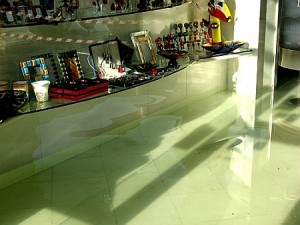
“Furthermore,” Canestrelli goes on, “we risk reaching the limit of our capacity. Up until last year the Center had 17 employees; now we have 13 and those include people in administration and motor-launch drivers. This leaves very few who are involved in the forecast service. With this level of personnel, during the high-water season of October till May, we can’t monitor the situation 24 hours a day.”
And a note that is drowned-out in the chaotic chorus of who needs to know how high the water’s going to be is from the so-called ecological workers. Not so much for collecting the trash, which they overlook on high-water days, but because they have to know — in advance, please — whether they’re going to need to muster the troops to set up the passarelle, or temporary walkways. Preferably before the water is above the ankles.
The clever thing to do, it would seem to me, would be for the Tide Center to estimate the tide toward the higher end of the scale. Just to be on the safe side. I was very proud of myself for coming up with this clever and amusing idea.
Then Canestrelli told the Gazzettino that that’s pretty much what they’re doing.
So all this being said, let us dial down the volume on the wails preceding the next expected high tide. It may turn out to be a little — or somewhat — or a lot — different than you thought it was going to be. I suggest you buy a pair of boots and get on with your life.


